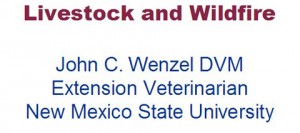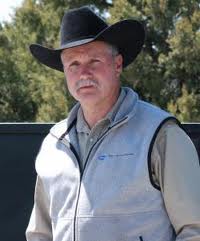
 At last months New Mexico Cattle Growers Association meeting I had a chance to meet and talk with veterinarian Dr. John Wenzel. He gave two very interesting talks, but because of the major wildfires burning in New Mexico at the time of the meeting the one that got the most attention was about animal care during and after major fires. Journalist David Bowser has done a great job writing up that speech which I hope you will find interesting.
At last months New Mexico Cattle Growers Association meeting I had a chance to meet and talk with veterinarian Dr. John Wenzel. He gave two very interesting talks, but because of the major wildfires burning in New Mexico at the time of the meeting the one that got the most attention was about animal care during and after major fires. Journalist David Bowser has done a great job writing up that speech which I hope you will find interesting.
By David Bowser
First appeared in Livestock Weekly
SANTA FE, N.M. — While many of the speakers at the summer meeting of the New Mexico Cattle Growers Association here recounted the destruction wreaked by wildfires this year, Dr. John Wenzel, the veterinarian with the New Mexico State University Cooperative Extensive Service, turned his attention to caring for the animals that survive the fires.
Wenzel said the first consideration, of course, is to get the cattle out of the way of wildfires. The second consideration is to care for cattle that have been injured.
The cattle, injured or not, need to be evacuated from the area of the fire.
Job number one, the veterinarian said, is hydration.
“Those cattle have been without water for a long period of time,” Wenzel said.
They need to be watered.
“If they’ve been moving a lot,” he noted, “they’ve been shut down for a long time.”
The feed situation may be bad, but the water situation is critical.
“We want to make sure they get water.”
Any injuries the cattle suffer also need to be addressed.
“There are going to be some injuries that occur from heat and the effects of that fire,” he pointed out.
Some of those effects may not be readily apparent, he warned.
“Some of those things you don’t really know until later.”
He said some of the cattle may have burns that aren’t really that evident.
“They don’t show, but the skin blisters later on.”
Wenzel said the cattle have to be watched so when symptoms become apparent, they can be treated promptly.
Calves in particular need to be watched.
“They’ve just gone through tremendous stress,” Wenzel reminded.
He said the worst thing cowboys can do is start pushing on them, start moving them.
“That needs to be considered in these evacuation plans,” Wenzel cautioned.
The cattle need to be evacuated far enough away from the fire that they won’t have to be moved again, he said.
“They need the opportunity to kind of recover before we start trying to put them back.”
It doesn’t help, he said, to move them two miles down the road and then move them another couple of miles the next day and move them again the following day.
“In those emergency plans,” Wenzel said, “you need to consider where you can take those cattle and get them out of there.”
The animals have to be handled carefully, he insisted.
“Those cattle have just been through a tremendous amount of stress, and that stress is a killer.”
Wenzel warned that moving them to a base of fire operations with all its activity, only adds to the stress on the cattle, and the cattle won’t recover.
He said when the cattle are being fed again, they need to be started on roughage.
“In some situations it’s going to be whatever we can find. There’s no doubt about that.”
Wenzel said that whatever they’re fed, it needs to be easily digestible.
Cattle that have been dehydrated shouldn’t be fed too high a protein initially.
“They may not be as functional as they need to be,” he said, “because of the dehydration problems.”
Wenzel said that some cattle that have been off water for a while and under stress may not take water.
They may have to be forced to take water.
Electrolytes can be added to water to help them recover.
“If you can do that,” he said, “that’s going to be very helpful to those cattle.”
Wenzel said that often when cattle are moved in a hurry, the triage takes place at the place they arrive.
“There may be some broken limbs,” he said. “Those cattle need to be taken care of immediately.”
Wenzel said there may also be some burn injuries.
“Those burns are extremely painful,” he pointed out.
Pain medication may be needed.
“We want to do things with as little stress as possible.”
With burns, Wenzel said, large surface areas may be involved, and infection can be a real problem.
“Those cattle are stressed anyway,” he said. “They don’t have an immune system that’s very operational at this point.”
Antibiotic therapy is used under such conditions.
Usually, it will take some time. One treatment probably won’t be enough.
Wenzel said that with pain medication, there aren’t a lot of choices.
That means that ranchers have to be careful about withdrawal times.
“Most of these cattle aren’t candidates for the slaughterhouse somewhere,” he admitted, “not in the shape that they’re in. But we still have to keep that in mind.”
Wenzel said that when all the wildfires began in New Mexico, one of the questions he had was about the smoke.
“The smoke can be thick and severe in these cases,” he said.
In talking with veterinarians at Kansas State University, he found that there’s not a lot of information on smoke inhalation in cattle.
“What is out there indicates that it is not a great big problem in animals that are in an outdoor fire.”
It’s a different situation, however, if they are in a barn or enclosed space.
But in a fire outdoors, there’s not much need for concern about smoke because cattle and horses have such long airways.
It is more of a concern for humans because of the shorter airways, he said.
Wenzel said that usually any smoke inhalation problems with cattle won’t be widespread, but could affect individual animals.
In treating individuals, he said, most of the treatment will be with antihistamines and anti-inflamatories.
There is a danger of using steroids on pregnant cattle, he warned.
“There has to be some care.”
If the animal has to be destroyed, he said, it’s important where to shoot it.
He said that while cattlemen understand, many involved in fighting wildfires may not.
“That’s a concern,” Wenzel said.
If it’s not done correctly, it can be a difficult process.
He said county management plans need to designate emergency responders who have the background to quickly be able to put down injured animals.
“Firearms are most likely the method that’s going to be used,” Wenzel said, “because they’re the most economical and readily accessible, especially with a widespread livestock loss.”
At least a .22 magnum round should be used, he advised. A larger caliber round should be used with dairy cattle or bulls.
“There’s also another method that’s acceptable,” he said. “That’s a cap and bolt, but that’s not readily available. So basically, we’re looking at firearms.”
Wenzel said that most uninformed people think the animal should be shot between the eyes, but the animal should be shot above that point.
Using the top of the ear to the opposite eye, where the lines cross is the point where an animal should be shot.
“We need to know what we’re doing,” Wenzel said.
He said most people don’t think about shooting them that high.
“In certain situations, especially in trailers,” Wenzel said, “we’ve got to do it that way.”
He said people need to be trained to do this properly.
“It’s a good idea to see that emergency responders in your area are trained in such situations.”
As with most preparations for wildfires, lessons need to be studied and learned beforehand.
___________________________________________________________________________________________________________
Dr. John C. Wenzel is a New Mexico native, born and raised in Albuquerque’s south valley. He attended New Mexico State University and graduated with a BS degree in Agriculture in 1982. He attended Kansas State University College of Veterinary Medicine and graduated in 1986 and then joined a mixed practice in the Albuquerque area. In 1987, Dr. Wenzel moved to the Silver City, NM area and joined a rural mixed animal practice as an associate veterinarian and purchased the practice in 1991.
Dr. Wenzel’s professional career has concentrated on cow/ calf medicine and preventative health programs for livestock producers in southwest New Mexico. In 2006, he joined the faculty at NMSU in the Department of Extension Animal Sciences and Natural Resources as the state’s first Extension Veterinarian. He is the state coordinator for the NM-ALIRT (Ag/ Livestock Emergency Response Team) and the NM Beef Quality Assurance programs. Dr. Wenzel is also on the NM Veterinary Medical Examining Board, the Veterinary Advisory Council of the Western Interstate Commission on Higher Education, the Veterinary Advisory Committee for the Central NM Community College Veterinary Technician Program, the Advisory Committee for the NM Veterinary Diagnostic Laboratory, the Academy of Veterinary Consultants and the Western States Livestock Health Association. He has also developed the New Mexico Rural Veterinary Practice Relief Program, a collaborative effort between New Mexico and Kansas State University College of Veterinary Medicine to send qualified rural students to the Veterinary college with an agreement to return to NM and practice in a rural setting.
